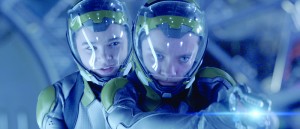The poster for “Ender’s Game,” hoping to symbolize a science fiction story as representative of 1980s young adult interest in adventure and violence just as “The Hunger Games” is today, states in dramatically large design, “This Is Not a Game.”
Not since “Pacific Rim” has a movie advertised such an amusingly ridiculous tagline. Obviously, this is a game, one that director Gavin Hood plays decently, but not smoothly enough to definitively call him a victor.
In a future not too unresembling of the present, Earth is under an immense amount of stress from an alien attack that happened years prior by the Formics, a mysterious race compared heavily to large ants. Knowing that they had almost lost the first time, the International Fleet, a sort of United Nations interstellar army, recruits teenagers as battle specialists, hoping they can learn and strategize to a higher capacity than adult military leaders could.
The story focuses on the titular character, Ender (Asa Butterfield) as he rises through the ranks of Earth school loser to space school sergeant, easily rising above every challenge set in front of him. Most of the cast is filled out with individuals that befriend Ender along the way, convincing him that he is indeed the destined adolescent savior of the human race. These include Colonel Graff (Harrison Ford), the stern mentor, and Petra Arkanian (Hailee Steinfeld), the talented friend.

[media-credit name=”Courtesy of Summit Entertainment” align=”aligncenter” width=”300″]
These faults, at least, are presented in an entertaining manner. With a supporting cast that reaches for the Oscar stars, including Viola Davis, Ben Kingsley and Abigail Breslin, several emotional moments let the actors do their best with what is given. None of these characters find any development, but at least they look the part, remaining appealing all the way to the point of fault.
Presented with the opportunity to adapt a story as acclaimed as “Ender’s Game,” Hood, also the film’s writer, is given the chance to take as many or as few liberties as he wanted. The film skips from scene to scene with the feel of a theatrical play, passing each act without much transition or dramatic development to let the characters or audience take a breather.
The worst thing about the “Ender’s Game” film, which was adapted nearly three decades after the initial publishing of the novel, is that it feels like it was completed in a desperate rush. Had Hood worked more succinctly with Scott Card’s original work, perhaps even extending the film’s plotline to accommodate for the sure-to-be-present aspirations to adapt the novel’s sequels, he may have gotten a less contrived result.
Luckily for Hood, the budget saves him an embarrassingly large amount of critique. The oddly separated acts centralize on several commendably created thrilling moments, which mix the talents of the actors with visual effects and well-created tension.
It’s a wonder why the film wasn’t made or produced in 3-D, an appeal that would have likely gripped the audience and earned the production crew more revenue than it was worth. Maybe “Ender’s Game” was actually made in a hurry, with Hood quickly moving along from climactic moment to climactic moment without considering what would have been best for the flow of his orchestration.
A highbrow grandiosity and wealth of interesting scenes keep “Ender’s Game” from being boring, just fuddled and creatively shallow. Several moments, notably toward the conclusion, make the extended wait for Scott Card’s intended masterpiece barely worth it. However, at the end of the day, a lot of meaning and drive are visibly lost on the cutting room floor.
“Ender’s Game” is sure to be remade again in the future, ideally with more care and patience. But for the time being, Hood’s admittedly vivid imagery will have to do.

Not in 3D is a good thing. I don’t need to shell out for a dimension I’m not going to use